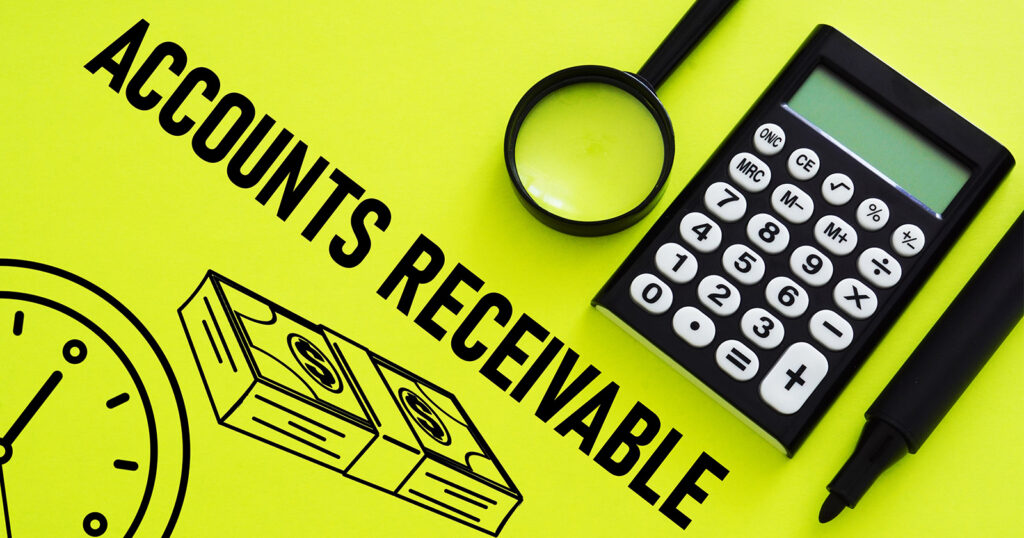There are many balance sheet accounts that every accountant or small business owner needs to be familiar with when learning accounting skills and accounts receivable is an important topic.
Just like accounts payable, accounts receivable can have its own department in accounting and jobs. We’ll look at what accounts receivable means, a definition and an example. The goal is to have a good grasp of accounts receivable in just a few minutes.
Let’s dive into it!

What Does Accounts Receivable Mean? (Definition Explained)
Accounts receivable (“AR”) are balance sheet accounts that represent the balance owed to a company by its customers for services or goods purchased using credit offered by the company.
Unless a customer pays cash, amounts due by customers will be recorded in the accounts receivable.
Accounts receivable should be settled on a short-term basis (up to 12 months) and are presented in the current assets of the balance sheet.
ARs are considered to be highly liquid because a company has a legal right to request the settlement of their accounts receivable and the customers have an obligation to pay.
Accounts Receivable Debit or Credit
Accounts receivable are part of assets which means they’re debit accounts by nature. An increase in receivables means the accountant needs to debit the accounts receivable.
When the company receives funds from its customers, the accountant decreases the accounts receivable by crediting the accounts.
Read More:
A General Ledger Example| Understanding the GL in Accounting
How to Account for Accounts Receivable
A journal entry always needs a debit and a credit side in order to balance. When an entity makes a sale and agrees that the customer pays at a later date, the company will issue an invoice with payment terms.
The entity will need to debit its accounts receivable and credit an income account related to the goods or services sold. When the entity receives money from its customer, the accounts receivable need to be decreased by the settled amount.
This is done by crediting the accounts receivable and debiting the cash account, which means the cash has increased from money paid by the customer and the AR for that customer has decreased or eliminated.
Accounts Receivable Journal Entry (An AR Example)
Let’s break it down and look at Carl’s Construction Company (“CCC”). Imagine CCC just built kitchen cabinets for a customer and charged $5,000 for its services and supplies.
CCC issues an invoice expecting full payment within a month. CCC will debit $5,000 in the accounts receivable, in the current assets on the balance sheet.
At the same time, in order to offset this transaction, CCC also credits $5,000 as revenue in the income statement. A month later, CCC receives the customer’s payment via bank transfer.
In order to eliminate the accounts receivable, CCC will credit $5,000 in accounts receivable and debit $5,000 in the cash account.
To record the receivable.
| Date | Account | Debit | Credit |
| August 31 | Accounts receivable | $5,000 | |
| Revenue | $5,000 |
To clear the receivable and increase cash.
| Date | Account | Debit | Credit |
| September 30 | Cash | $5,000 | |
| Accounts receivable | $5,000 |
What Happens to Unsettled AR?

There are always risks in doing business. The possibility that a customer never pays their dues is something every business owner needs to consider. To avoid overstatement of income and AR, the accountant needs to write off any potential bad debt.
The easy way is to write off bad debt as and when we are made aware of it. You will debit a bad debt expense account and credit the AR since it needs to be eliminated. This is called the direct write off method.
The downside of this method is that it does not follow the accrual accounting principles. The direct write-off method allows you to write off bad debt in a different period than the period the revenue was earned.
In accrual accounting, one important principle is to ensure you record an expense related to the revenue earned in the same accounting period the revenue was generated. This is where the allowance method comes into play.
Read More:
Accounts Payable Meaning, Examples and Accounting Definition
The Allowance Method
The allowance method makes sure the expense for bad debt is recorded in the same period as the revenue generation period. The principle is to estimate an amount of AR that you expect will not be collectible and credit the allowance account with that amount.
It should be noted that this allowance account is also an asset account, just like the accounts receivables. The difference is that this allowance account is considered to be a contra-asset account that is used to net against the AR.
The debit side of the entry will go to a bad debt expense account. This entry will ensure the AR and revenue accounts are not overstated by bad debts.
If we look back at the CCC example above and imagine that the customer went bankrupt and CCC estimates that there’s a high probability that the customer won’t be able to recover the full $5,000 kitchen cabinets installation but could potentially pay $1,000, you will need to record the following entry:
| Date | Account | Debit | Credit |
| October 31 | Bad debt expense account | $4,000 | |
| Allowance account | $4,000 |
After recording the entry above, the total AR and revenue on this transaction would become $1,000 instead of $5,000.
Let’s Recap Accounts Receivable
We should have a better understanding of AR by now but let’s recap the highlights we covered.
- Accounts receivable are short-term highly liquid assets of an entity generated by sales made by the company where customers make use of credit payment terms.
- They are a normal debit balance. Debits increase AR and credits decrease AR.
- Accounts receivable are only receivables that are expected to be settled before 12 months’ time.
- AR is shown in the current assets of the balance sheet.
- If a company expects the AR cannot be collected, the AR needs to be written off.
Accounts Receivable Meaning: Final Thoughts
Accounts receivable are short-term assets of an entity generated by entering into an exchange of goods or services with a customer by extending that customer the option to settle via credit. They are debit-type accounts presented in the current assets on the balance sheet.
If you get really good in AR, you can have a career in accounts receivable alone. Though it is useful to learn AR, continue learning the rest of the balance sheet and income statement accounts. Don’t stop your knowledge here!



